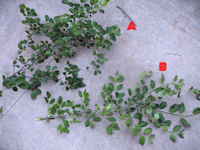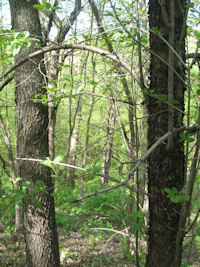What Does It Look
Like?

Sometimes it seems like "if its green and in the woods, its buckthorn".
But we all know that's not really true... almost. Unfortunately in more
and more areas it is getting to be sadly the case. Most of the pictures
taken on this web page were taken within a hundred feet of my own house.
There are two types of Buckthorn, Glossy (A) or Common (B).
Leaves:
● teardrop
(Glossy A) or egg shaped (Common B)
● curl backward or are folded
● veins
arching from the spine to the tip of the leaf (top third... usually ...
not always) (Glossy 8-9 veins or Common 3-5 veins)
● rough but not sharp edge Common (B); smooth edges Glossy (A).
Common (B); smooth edges Glossy (A).
The Branches:
●
almost across from each other.
The bark:
● younger plants is light
Common (B) to dark brown
Glossy (A) with white lines (or dash marks) in
it
● Older trees have a very rough bark similar to cherry
or plum trees but more
extreme
●
Yellow sap wood with orange heartwood
The picture at the right is a very good example of a typical
Buckthorn plant that contains berries in the late summer time. These
berries will remain on the bush well into the winter. You can click on this picture to see more detailed
information about the identification of Buckthorn plants. The most
defining feature of buckthorn is the THORNS. Sharp spikes that don't
seem too threatening on the sides of the branches, but if you work with
it, these spikes can penetrate leather gloves. Be prepared with plenty
of Band-Aids.
For more pictures on identifying Buckthorn,
click here.
 As a side note: When I first bought my current house before getting into
the tree business, I had a cherry tree I as very excited about. We had
cherry trees on our country home as a child and I loved the
cherries. It was a childhood memory and I babied this tree to get it to
produce but the fruit was sour and not very big. After starting our tree
service and completing our arborist training we had been in business for
some years when my son, Aaron said "When we going to cut that Buckthorn
tree down you been saving all these years?".
As a side note: When I first bought my current house before getting into
the tree business, I had a cherry tree I as very excited about. We had
cherry trees on our country home as a child and I loved the
cherries. It was a childhood memory and I babied this tree to get it to
produce but the fruit was sour and not very big. After starting our tree
service and completing our arborist training we had been in business for
some years when my son, Aaron said "When we going to cut that Buckthorn
tree down you been saving all these years?".
In my defense you need to enlarge the picture at the left to see for
yourself. The tree on the left is a Cherry tree and the one on the right
is a buckthorn. OK, sure when they are side by side they do not look at
all alike, but you have to admit if you had not been given all this
great information, you too might have mistaken the buckthorn for a
cherry tree. |